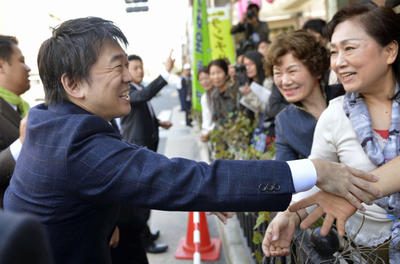Yet few people outside of the Osaka area have a sense of this new party or its leader, Osaka mayor Toru Hashimoto.
The Osaka Restoration Association, led by Hashimoto, is a major force in Osaka. It holds the top two offices of prefectural governor and mayor. On 12 September 2012 Hashimoto founded the JRP as a national political party with the aim of running 350 to 400 candidates for the lower house in the next national election, which may be held by the end of this year.
JRP candidates are mostly former governors and mayors who have gathered around Hashimoto, plus a group of nine incumbent members of the Diet who have recently become JRP members. They are joined by some 900 individuals selected from among 2000 participants in a series of private seminars organised by Hashimoto and known as the Restoration Prep School.
But the rushed expansion of the Osaka-based political party into a national organisation has given rise to a great many problems.
Hashimoto may have overreached in trying to create a political party. The JRP’s major policy is to transform the governing structure of Japan from centralised bureaucratic rule to decentralised rule by elected officials, but in its Eight Measures for Restoration, the JRP’s platform was extended to include a neoliberal fiscal policy and a social security policy based on self-reliance, competition and natural selection. The Eight Measures also deal with foreign policy and security issues, and include proposals to abolish the House of Councillors and elect the prime minister directly. These policy positions have yet to be fully defined, and the party’s inexperienced candidates may find it difficult to defend them.
The poor quality of the JRP candidates is another problem. Some of the former governors running for the JRP are embroiled in scandals involving women, and the media has taken to referring to the 900 or so students as ‘Hashimoto’s Babies’, signalling that the candidates are a bunch of young mediocre politicians. Their behaviour is providing fodder for negative reporting. If Hashimoto’s candidates fail to present compelling arguments for JRP policy, the sense of excitement surrounding the new party could quickly wither away.
The party has been criticised by liberal and conservative publications alike. For liberals, the interference with personal freedom involved in such policies as monitoring teachers who object to singing the national anthem during school ceremonies — by watching to see if their lips move — is intolerable. Many conservatives oppose Hashimoto on grounds that he does not honour tradition in the slightest, including in cultural matters.
Two recent studies on Osaka elections concluded that most of the support for Hashimoto in his home Kansai region came from high-income full-time employees with stable jobs, not (as was thought) lower-income workers and the younger generation, who are anxious about employment and income issues.
The author of one of these studies, Mitsuru Matsutani, an associate professor at Chukyo University, argues that support for Hashimoto reflects three distinct changes in social consciousness in Japan: growing jealousy toward public officials who enjoy relatively high incomes and stable employment, the neoliberal orientation of the urban upper middle class, and an increasing trend toward nationalism.
Proposals for substantial reform of the bureaucratic system are common to most political parties in Japan, but after the DPJ failed to achieve effective bureaucratic reform nationally, Hashimoto’s success in Osaka seems remarkable. Hashimoto’s relentless attacks on civil servants in local governments in Osaka for their conspicuous corruption earned him popularity as a strong leader. By supporting Hashimoto, the upper middle class is betting he can succeed nationally as he has locally.
So Hashimoto’s ability to continue to deliver results on reform is key to maintaining political momentum. Hashimoto’s signature tactic of turning civil servants and Board of Education members into bad guys and then fiercely attacking them has paid off so far. But he is yet to implement his main policy promise of abolishing the dual structure of administration for Osaka City and Osaka Prefecture and to reorganise the region into several new autonomous districts. Coordinating this reform, known as the Osaka metropolitan initiative, will be a major challenge.
Hashimoto’s nationalism is also in question. His style of nationalism is more pragmatic than ideological, and he is more inclined to weigh advantages and disadvantages than taking doctrinaire positions. In a recent press conference Hashimoto made a statement about the Takeshima/Dokdo islands dispute that is likely to be seen as another ‘reckless remark’ by most, and as an unforgivable retreat by right-wing nationalists.
In the recent LDP party election former prime minister and hardline nationalist Shinzo Abe was elevated to party president, which also makes him LDP candidate for prime minister. The JRP had tried but failed to recruit Abe as leader, which will force Hashimoto’s party into a nationwide campaign battle with the LDP. After Abe’s election, the JRP’s nationalism is no longer as powerful a weapon as it hoped it would be.
At this moment, Abe calls the JRP a ‘good rival’, but it is unclear whether the JRP would participate in an Abe administration after the election. A post-election coalition between the LDP and JRP depends both on election results and intra-party balance in the LDP, where many dislike Hashimoto.
Yoshisuke Iinuma is contributing editor for The Oriental Economist.
A version of this article was first published in the October edition of The Oriental Economist.

